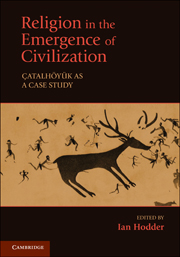Book contents
- Frontmatter
- Contents
- List of Figures and Tables
- Contributors
- 1 Probing religion at Çatalhöyük
- 2 The symbolism of Çatalhöyük in its regional context
- 3 Spiritual entanglement
- 4 Coding the nonvisible
- 5 Modes of religiosity at Çatalhöyük
- 6 Is there religion at Çatalhöyük…or are there just houses?
- 7 History houses
- 8 Marked, absent, habitual
- 9 Temporalities of “religion” at Çatalhöyük
- 10 The Neolithic cosmos of Çatalhöyük
- 11 Magical deposits at Çatalhöyük
- 12 Conclusions and evaluation
- Index
- References
3 - Spiritual entanglement
Transforming religious symbols at Çatalhöyük
Published online by Cambridge University Press: 05 June 2012
- Frontmatter
- Contents
- List of Figures and Tables
- Contributors
- 1 Probing religion at Çatalhöyük
- 2 The symbolism of Çatalhöyük in its regional context
- 3 Spiritual entanglement
- 4 Coding the nonvisible
- 5 Modes of religiosity at Çatalhöyük
- 6 Is there religion at Çatalhöyük…or are there just houses?
- 7 History houses
- 8 Marked, absent, habitual
- 9 Temporalities of “religion” at Çatalhöyük
- 10 The Neolithic cosmos of Çatalhöyük
- 11 Magical deposits at Çatalhöyük
- 12 Conclusions and evaluation
- Index
- References
Summary
The overall aim of the three-year interdisciplinary project at Çatalhöyük was to explore the extent to which spiritual life and religious ritual may have been involved in the momentous shift toward sedentism and agriculture, which are typically connected to the emergence of “civilization.” In The Leopard's Tale (2006) Ian Hodder offered his own initial analysis of the role of the religious sphere (among others) in the social transformations that are evident through time and space at Çatalhöyük, proposing a theory of “material entanglement.” I find his interpretation plausible and compelling, and in this essay suggest a complementary perspective on the data that develops and makes use of the idea of “spiritual entanglement” as a conceptual framework for beginning to respond “theologically” to the four interrelated research questions that guided the project.
My strategy will be to take Robert Neville's pragmatic theory of religious symbolism, which deals primarily with axial age religions and has been applied to contemporary interreligious dialogue, and apply it imaginatively to the study of religious transformations during the early Neolithic. Besides its general illuminative power, Neville's model also commends itself to this task because its use of the semiotic metaphysics of C. S. Peirce provides a point of contact between the disciplines of theology and archaeology. Neville's emphasis is on what symbols do, on their transformative power and the way in which they are transformed by intentional agents in concrete communities. As we will see, he describes religious symbols as those that persons “take” in particular contexts in their pragmatic attempts to engage the ultimate boundary-making conditions of their lived world.
- Type
- Chapter
- Information
- Religion in the Emergence of CivilizationÇatalhöyük as a Case Study, pp. 73 - 98Publisher: Cambridge University PressPrint publication year: 2010
References
- 5
- Cited by



